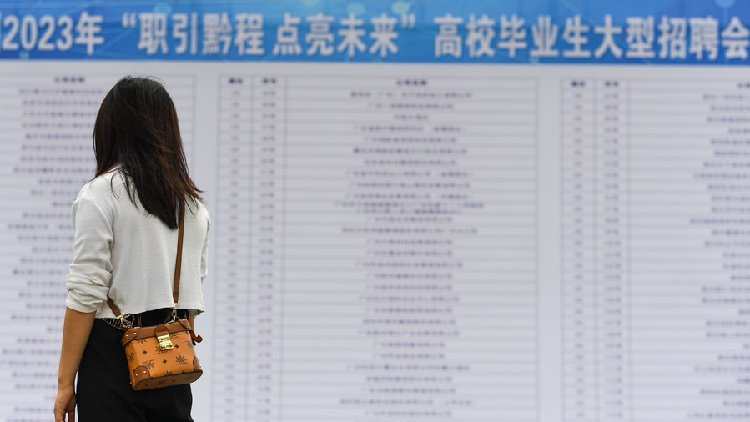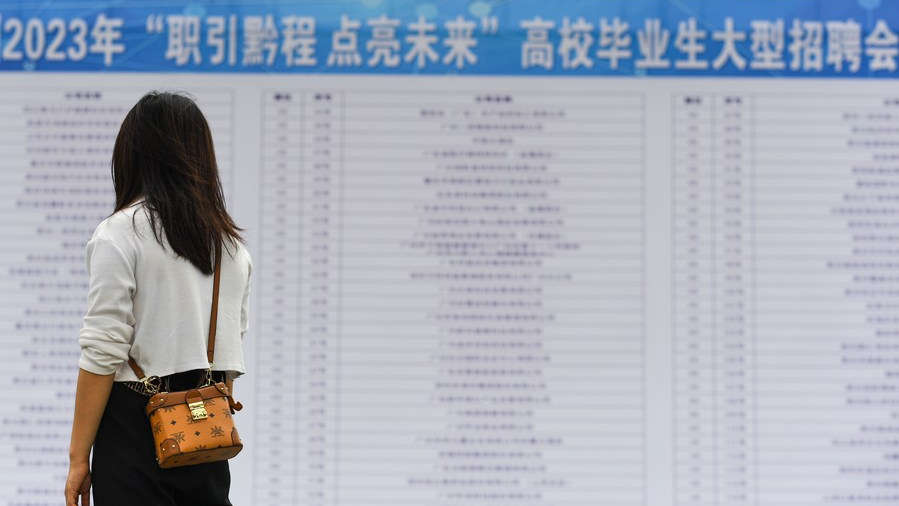Challenge and promises of China's education system
A college graduate reads recruitment information at a job fair in Qiandongnan Miao and Dong Autonomous Prefecture, southwest China's Guizhou Province, June 30, 2023. /Xinhua A college graduate reads recruitment information at a job fair in Qiandongnan Miao and Dong Autonomous Prefecture, southwest China's Guizhou Province, June 30, 2023. /Xinhua Editor's note: Wang Yan, a special commentator for CGTN, is the director of Chinese Society of Education Developmental Strategy. The article reflects the author's opinions and not necessarily the views of CGTN.At a recent press conference on China's achievements in reform and development in education since the 18th National Congress of the Communist Party of China (CPC), China's Minister of Education Huai Jinpeng was challenged by a sharp question raised by a young journalist from the Wall Street Journal: "Does 20 percent of youth unemployment rate reflect a


A college graduate reads recruitment information at a job fair in Qiandongnan Miao and Dong Autonomous Prefecture, southwest China's Guizhou Province, June 30, 2023. /Xinhua
Editor's note: Wang Yan, a special commentator for CGTN, is the director of Chinese Society of Education Developmental Strategy. The article reflects the author's opinions and not necessarily the views of CGTN.
At a recent press conference on China's achievements in reform and development in education since the 18th National Congress of the Communist Party of China (CPC), China's Minister of Education Huai Jinpeng was challenged by a sharp question raised by a young journalist from the Wall Street Journal: "Does 20 percent of youth unemployment rate reflect a weakness of China's higher education system, and are tertiary education graduates equipped with the right skills to enter the work force?"
What does 20 percent unemployment rate imply? Minister Huai explained that 20 percent is 2-3 percent higher than the figure of the corresponding period last year, and that 20 percent seems higher than the figure of many other countries. Statistical data count, yet they could be illusive. Taking a closer look, 20 percent of youth unemployment rate does not reflect the full picture of China's youth employment. Youth unemployment rate is defined as the number of unemployed 15-24 year-olds expressed as a percentage of the youth labor force. However, most of the youth of this age in China are students at primary or tertiary level, with 91.6 percent of gross enrollment rate in upper secondary education and 59.6 percent of gross enrollment rate in higher education.
Meanwhile, according to China's National Bureau of Statistics, among 16 to 24 year-olds, 33 million are looking for a job in the labor market, with 26 million having already secured a job and 6 million reportedly to sign an employment contract.
As a matter of fact, these figures refer to standard employment instead of digitally-enabled new modalities such as platform work, which is gaining popularity among China's youth. As a result of digital transformation accelerated by the COVID-19 pandemic, digitally-enabled work is flourishing and the number of people engaged in such activities is increasing rapidly. Platform work is becoming the preferred option for many young people in China, including individual contractors, the self-employed or freelancers.
Is there weakness in China's higher education? Certainly! Yet the answer also applies to all education systems, in the United States as well as elsewhere. Whenever the government designs a new curriculum and compiles or approves new textbooks, changes occur. Hence in a certain sense, education always "lags behind." Besides, everybody has gone through the education system, either in kindergarten, schools and universities, and has thus gained evidence to support their case for or against quality and equity of their education system. In particular, in the context of China that has inherited a culture of valuing education and holding high expectations for children, provision of education has become the most demanding task.
On the other hand, admittedly, to ensure fair and quality education for every child, more needs to be done. As noted by President Xi Jinping in his address at the CPC Central Committee Political Bureau meeting on May 29, China shall engage in a system-wide reform, breaking through all conceptual, administrative and structural constraints for quality and equitable delivery of education, in particular, to narrow rural-urban, inter-regional, inter-school/institutional gap, and to reform education assessment system toward more options and modalities for learning assessment. Moreover, in response to digital transformation, more efforts will be made to advance digital education to facilitate personalized and lifelong learning, extend access to digital resources and facilitate education modernization.

Students learn about job opportunities at a job fair in Harbin, northeast China's Heilongjiang Province, February 7, 2023. /Xinhua
Are tertiary education graduates equipped with the right skills to enter the work force? Skill mismatch – what is offered by the education sector does not match what is demanded by the labor market – is indeed a global challenge. Globalization, technological progress, demographic changes, migration, climate change, and COVID-19 pandemic have all contributed to rapidly change the demand for a skilled workforce – what skills or what talents education systems generate – thus compounding the complexity of education provision.
On top of these, the 20th Party Congress, for the first time in history, launched a new tripartite development strategy of "science, education and talent/skills." It mandates concerted innovation of vocational education, higher education, and continuing education as well as integration of vocational and academic education, industry and academia as well as science and education. It implies that the government devotes more resources to resolve the skill mismatch with an integrated approach through cross-sector collaboration later on.
During the brief conversation between Minister Huai and the journalist after the press conference, the journalist also referred to graduates' mindset and their assumed preference toward white-collar jobs. Nonetheless, as in many other countries, students and parents often prefer academic education to vocational education. Vocational education is perceived to be low-end, compared with other education sectors worldwide.
China is making a difference: the employment rate for tertiary vocational education institutions has exceeded that of general higher education institutions on average over the last 10 years. In recent years, the Ministry of Education has strived to scale up vocational education, and upgrade vocational education institutions. As a result, enrollment in tertiary vocational education institutions has been expanded with an addition of approximately 4 million students over the past three years.
The world is changing at an accelerating pace. And a future-oriented strategy counts, as is the approach to the formulation of the strategy for building a leading country in education. The strategy essentially could also be understood as building a strong nation through education. Education imparts values and beliefs, fosters integrity and morality, shapes character and ways of behavior, and equips students with learning methods and strategies. It not only lays the foundation for a person's lifelong growth and well-being, but also serves as a cornerstone of social and economic development. As Minister Huai said, when he approached the journalist after the press conference, "China has a huge student population and education is an important issue now and in the future. We should be confident, make improvements, and prepare our students for tomorrow's world."
(If you want to contribute and have specific expertise, please contact us at [email protected]. Follow @thouse_opinions on Twitter to discover the latest commentaries in the CGTN Opinion Section.)
What's Your Reaction?













